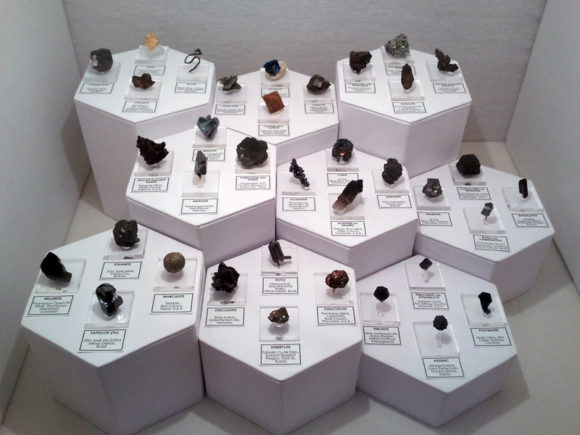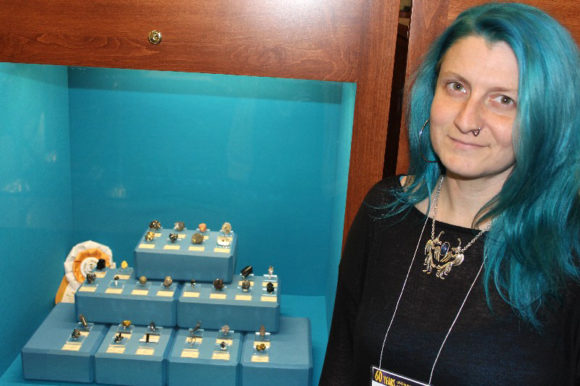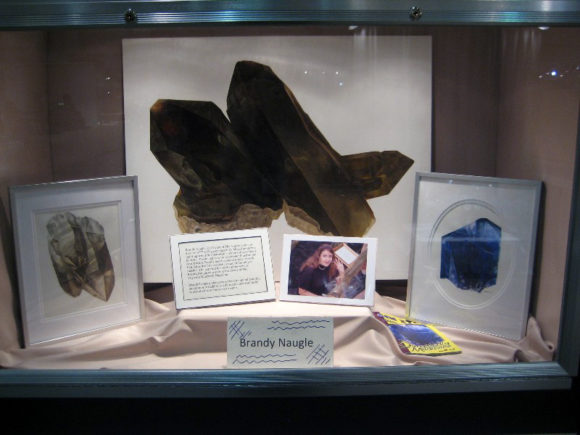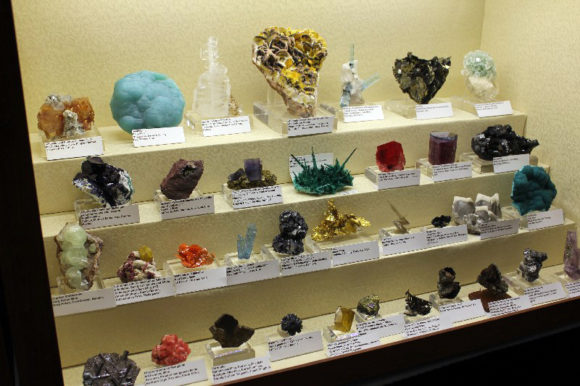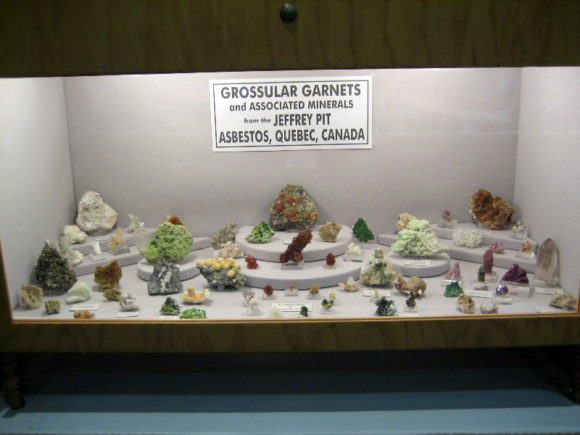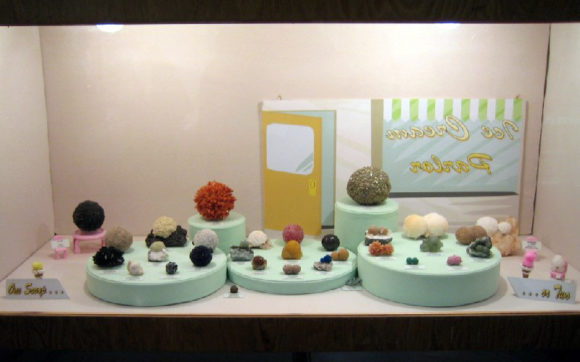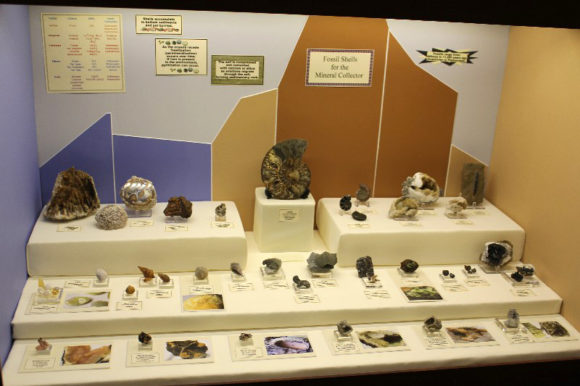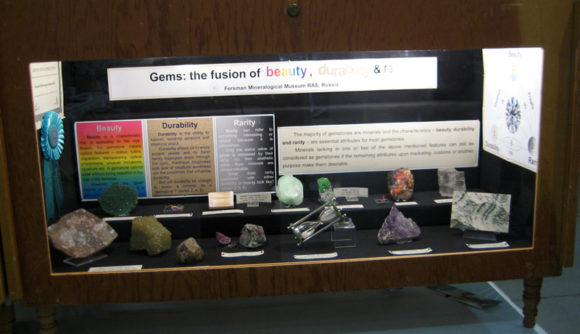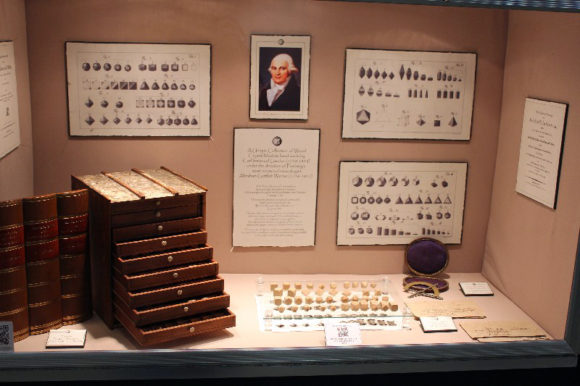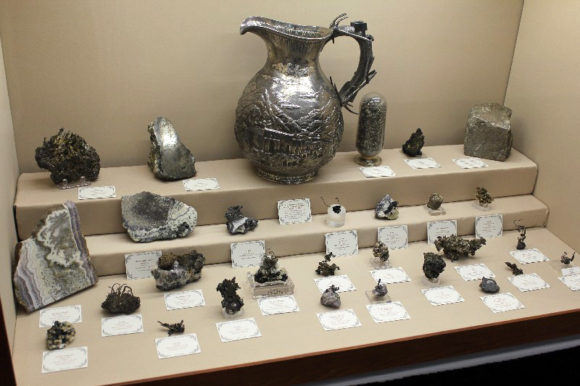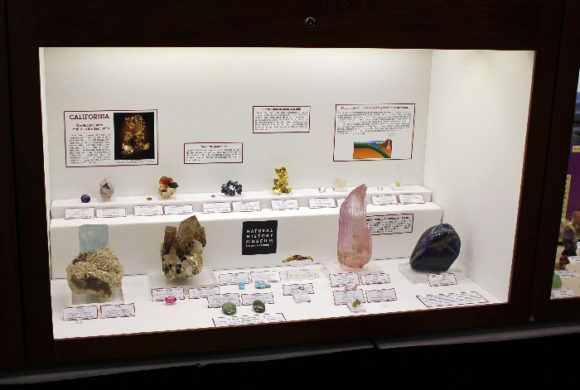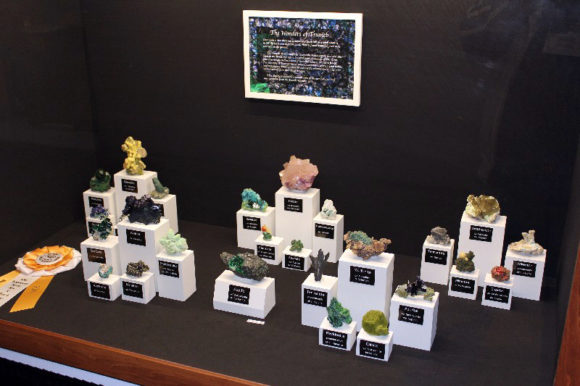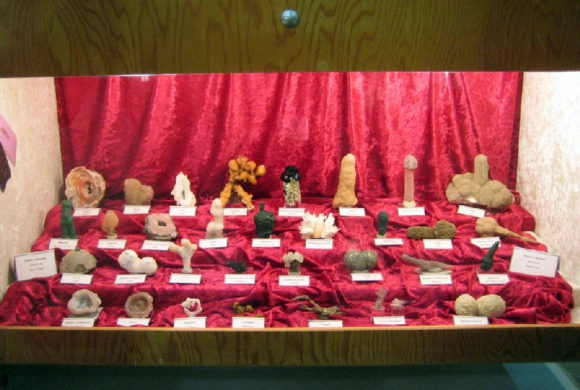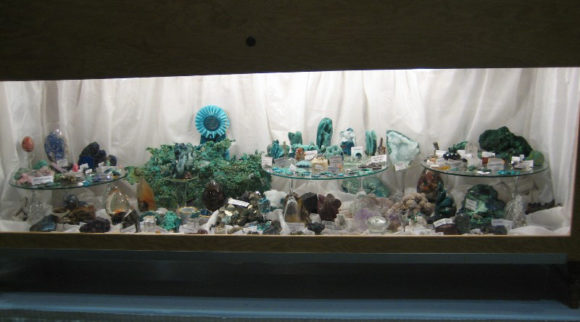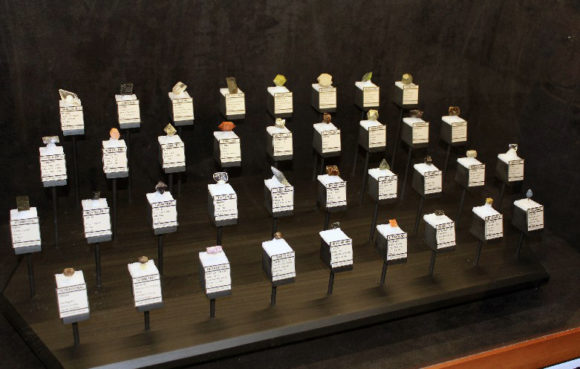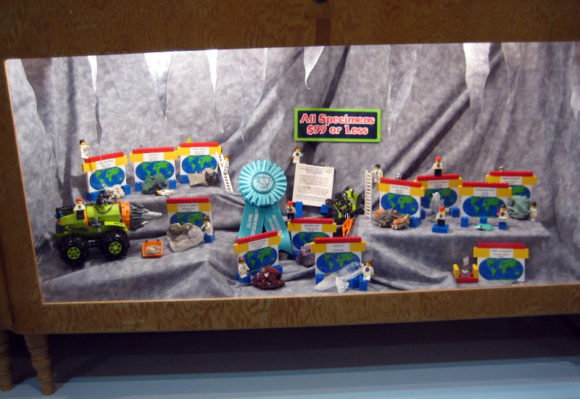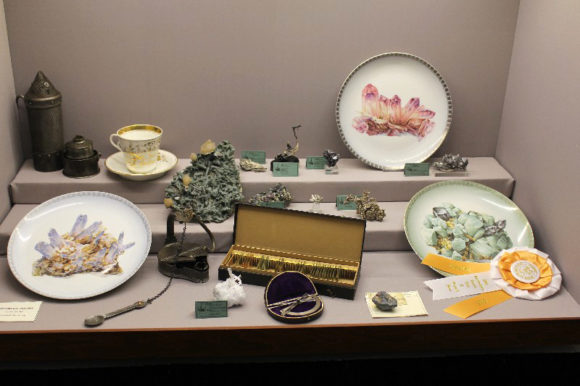As time goes by and your rock and mineral collection grows, you may start to ask yourself, “What can I do with all these rocks?” Of course you already display them at home and you are constantly showing them to your disinterested friends and family, but have you ever thought about showing your crystals to the public?
Creating a Display for your local rock or gem show is a fun and creative way to share your love of crystals and minerals with others. Most rock clubs love to have their members and other collectors within the community exhibit their gem and mineral collections during their annual rock shows and tail gates.
In my decade plus of working within the rock and gem show world, I have seen, and created a great many rock and mineral display cases… some even winning awards at the Tucson Gem & Mineral Show™. From this experience I present you with Brandy Zzyzx’s Best Practices Guide to Gem Show Display Case Design.
Step 1. Contact Gem Show Display Coordinator for permission to participate
The first step is contact the Display Coordinator for the Gem Show in which you wish to display. For larger mineral and rock Trade shows, this information is often easily found the show’s website, but for smaller, local shows many times this information is not listed on the show’s (or club that is hosting the show’s) website, or they do not even have a website. If there is no Display Coordinator, try to contact the Show Promoter or Show Chair. Or speak to any member of the hosting club that you may know, and they should be able point you in the right direction.
Before being able to exhibit your rocks, you will be asked to fill out 1 or more forms and/or releases. Each club as their own specific rules about cases, liners, and appropriateness for general (non-competitve) displays. More advanced collector’s may wish to compete for display awards that may be given out by the club. These types of displays have additional rules, specifications, and forms. If the club is a member of American Federation Mineral Societies, these competitive display rules and regulations are determined by the federation; making them consistent across all rock and gem shows in the US.
After you have secured a case for the duration of the gem show, and have been given the display case dimensions and the date of the show, it is time to plan exactly what you want to display and how to go about it. Sure you probably already have an idea of what you want to do, but now is the time to finalize those plans.
Step 2. Pick a Theme or Statement of Purpose for your display case
Anyone can throw some rocks in a case, but that doesn’t make it worth looking at. Don’t kid yourself; if you phone it in, everyone who sees it will be able to tell that you didn’t even try. So before you pick out any rocks, ask yourself why you want to put together a display case and your purpose for sharing your collection. The answer to this question will make putting your case together so much easier and aid you in creating a visually appealing display.
What is my purpose for displaying my rocks & minerals?
Answer 1.To showcase my collection of rocks & minerals
What one thinks of as traditional rock and gem show display cases. Usually they are a sampling of collector’s personal rocks and crystals, however they can also be compiled by a group of people or a case presented by museum or school. In some instances the display case may be on a theme, such as minerals all the same size, all specimens from the same locality, or all the same type of mineral. Traditional display cases usually have very little, if any signage except for specimen labels, because the rocks, crystals, or gems are the main focus of the display.
Answer 2.To teach the people about rocks & minerals
Display cases that are educational in nature are usually submitted for display from schools and museums; however it is not uncommon for companies and advanced mineral collectors to also create informative displays for larger, international gem and trade shows. Sometimes the displays are scientific and technical in nature, often times showcasing more specialized or vocational rock and mineral information.
Another popular example is detailed timeline of the operations of particular locations or discovery history of a specific mineral type. These types of displays usually have many signs, graphs, charts, photos, and labels; sometimes even paragraphs of text to read. Illustrating and educating the viewer about the rocks or minerals is the primary focus of the display; specimens are used to convey the information
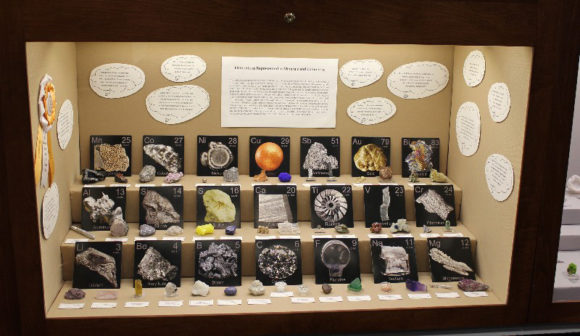
Eye catching display pairs real mineral specimens with printed stand-up pictorial signs representing elements from the periodic table
Answer 3.To share my experiences with rocks & minerals
Display cases that may be related to rocks and minerals, but are actually more about telling a story or relaying a feeling or memory. These types of displays are often very different from the displays around them; they showcase the achievements or thoughts of the humans involved as the main focus.
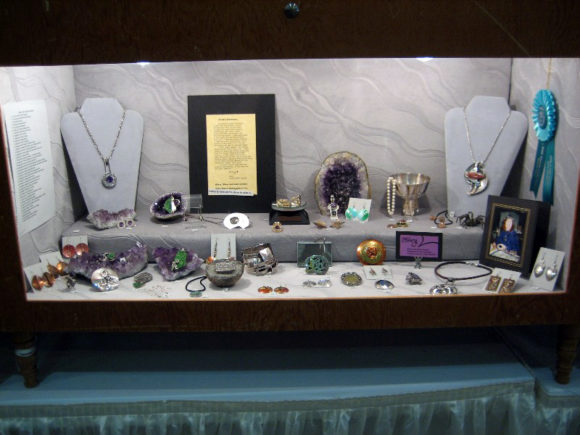
Sharing your hobby or craft in a gem show display case is a great way to get both exposure and feedback on your creations.
The rocks and minerals provide a social construct for the sharing of mutual interests and experiences. Immediately recognizable, most commonly seen examples are displays of someone’s art, craft, or other creative endeavors, and what I call meta-displays. This is a display inside a display.
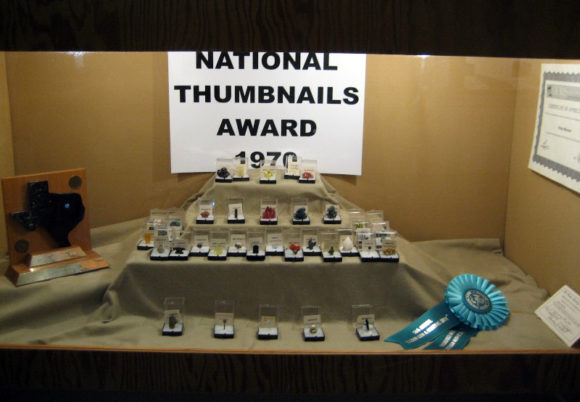
Creating a Meta-Display, or “display within in a display” is a clever way to commemorate a past achievement or memory.
For instance, the specimens and awards from a winning display case 25+ years ago recreated now. Memorial cases of photos and specimens of a departed collector or of a closed location are other ways to immortalize stories and experiences from our community’s collective past. These may be the hardest type of display to execute due to their personal nature. Although sometimes seen as cheesy, these cases are quite important; often times the stories and history of our collective past is otherwise forgotten if not shared.
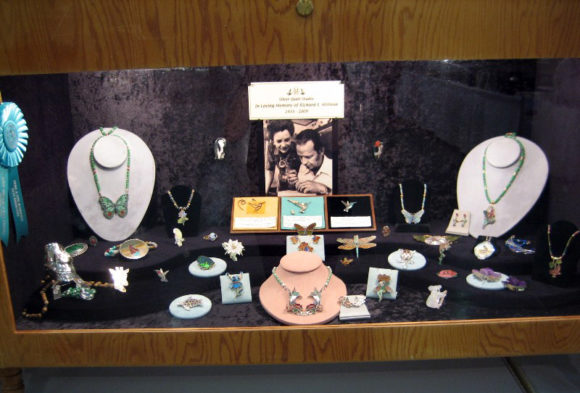
A memorial display is a meaningful way to reintroduce that younger generation of collectors to communities members that have passed away.
A great display may contain elements from multiple categories, but as a personal guide, I like to narrow down my themes. This will not only make it easier for you to decide what specimens to include, but will help the viewer be able to understand and appreciate your case quickly in a noisy/busy gem show environment.
Example: If your case is a display of mixed minerals from your personal collection, maybe choose specimens that are all the same size. Or conversely, if displaying all the same mineral from one location; showcase the different sizes, shapes, and color variations that can be found.
Choosing a theme or purpose for your display case creates a guideline to work within as you gather specimens and other elements. As you assemble your display, choose only items that will help further your purpose and stay within your desired theme.
Step 3. Plan and execute the actual design and presentation of your display case
Use of Size & Balance: A display case is essentially a box that you are filling. The very best, and most visually appealing displays are ones that utilize all 3 dimensions; length, width, and height. In order to take full advantage of the entire volume of a display case; risers, pedestals, and other display accessories are used to not only provide height, but to assist in the viewing of all specimens equally; this is especially necessary if the specimens are small or if there are many of them.
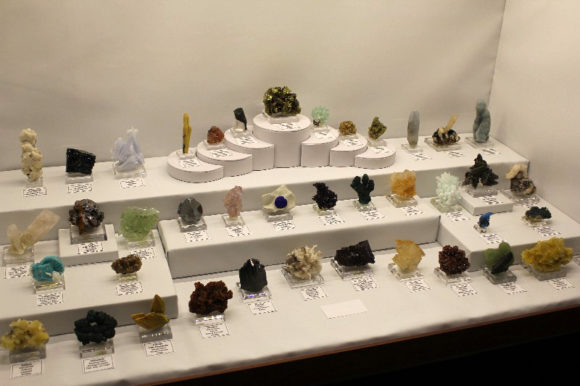
Combinations of risers in various sizes and shapes ensure that all specimens can be viewed equally well.
For mixed size mineral cases, place larger specimens in the back or on the sides of the display and alternate the spacing between rows to ensure optimal viewing of each specimen.
In certain displays signs and photos can be used to add height to an otherwise empty display; either on easels or by attaching them to the back of the case insert.
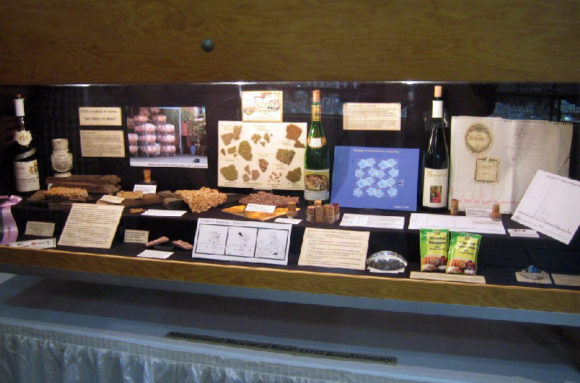
Signage can provide information to the viewer and ad additional height and interest to the overall case design.
Use of Color & Contrast: While many rock shows will provide you with pre-covered fabric liners for the inside of your display case, most people prefer to provide their own. This gives the exhibitor the ability to choose a color that will showcase their rocks or minerals in their very best light. For instance, if you are displaying a case of white or clear specimens you would probably want to choose a dark colored background material, as to provide visual contrast for the viewer. In some cases, you might want to use a monochromatic color scheme, like using a pink background for a case of hot pink rhodochrosite specimens.
When considering color, also remember that risers and stands are made of materials that also have distinct colors. Styrofoam is mostly white, display stands usually are clear or black plastic, and labels and signs are usually predominately white. All these elements will change how your specimens and your overall display is perceived by viewers.
Generally, neutral or natural colors are preferred for backgrounds, stands, and other non-specimen display items. Creative but tasteful use of color can enhance your display in some instances, but remember, “less is more.”
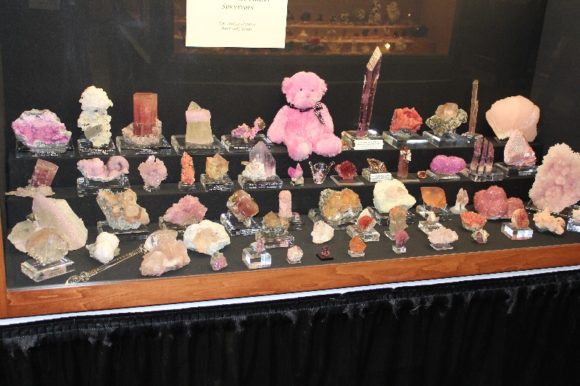
A monochromatic pink color scheme is being used as a means to draw attention to breast cancer awareness. Pairing pink specimens with black risers and clear bases creates a bold contrast that draws the veiwer’s attention.
Use of Tools & Materials: Even though just about anything can be used in the creating of a mineral display case, there are some materials and methods that are tried and true. Back and side case inserts are usually cardboard, foam core, or wood cut to size and covered in fabric that is secured in place by duct or masking tape. The best fabric to use is something not too stretchy or loose knit, and that is forgiving to marks and stains. Cotton, Blends, Suede, Canvas, Muslin, and Flannel are all materials I have seen used successfully. When covering your own case inserts, iron your fabric beforehand to remove creases before securing it to the background board.
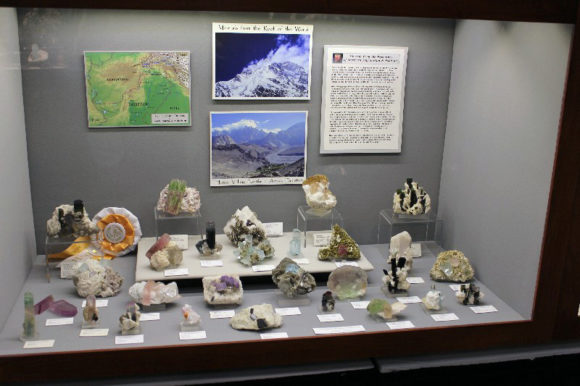 Stands and risers can be purchased pre-fabricated or DIY concepts of your own design. Materials used for risers are wood, plastic, Styrofoam, Foam core, or cardboard. Pre-fabricated risers and pedestals are often clear, white or black, but DIY risers made of foam or wood could be easily painted or covered with fabric to enhance the display or to create a custom effect. Those with special tools, skills, or talents could employ any number plastic, metal, polymer, or 3d printed bases, risers or stands to give their display a unique style or feeling.
Stands and risers can be purchased pre-fabricated or DIY concepts of your own design. Materials used for risers are wood, plastic, Styrofoam, Foam core, or cardboard. Pre-fabricated risers and pedestals are often clear, white or black, but DIY risers made of foam or wood could be easily painted or covered with fabric to enhance the display or to create a custom effect. Those with special tools, skills, or talents could employ any number plastic, metal, polymer, or 3d printed bases, risers or stands to give their display a unique style or feeling.
Small minerals and crystals are mounted on stands. These stands usually are foam or Lucite, with the specimen mounted with mineral tack, white glue, or hot glue. Before displaying, take into consideration what type of lighting will be used in the display case. Many smaller clubs still use hot burning display lights, so a specimen mounted to a stand with mineral tack my fall over under the heat of a display lamp. This is also true for signs and photos attached to backgrounds. For this situation, I would recommend high melting temperature hot glue to mount the specimens and a very sticky tape or possibly tacks for the pictures and signs (depending what the background material is.)
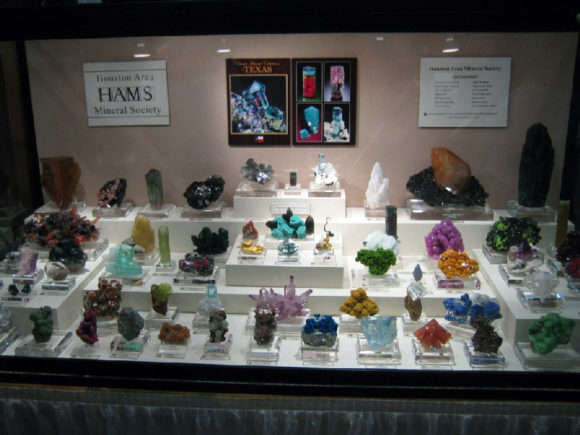
Making sure the viewer can see all specimens equally is especially important when displaying many similar sized specimens within a large display case.
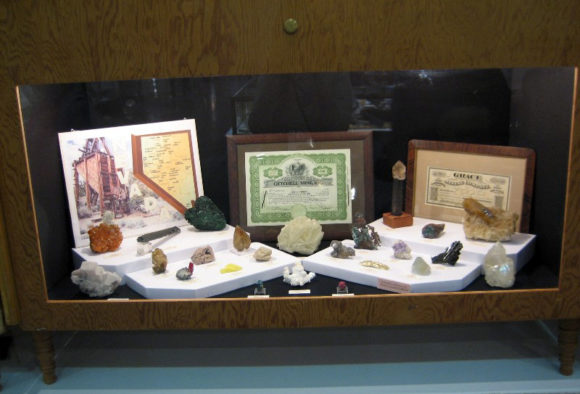
A combination of wide risers and framed documents is used to fill up the entire volume of this display case.
The inclusion of other types of ephemera as an accompaniment to the rocks and minerals is a way to help create interest, add height or to carry a theme. This could be documents, antiques, labels, models, optical equipment, plaques, souvenirs, etc.
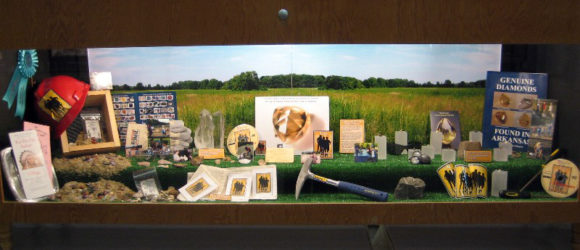
Tasteful and well thought out choice of non-mineral items can be used to reinforce your display theme or idea.
Step 4. Make sure your rocks and minerals are display ready
Orientation, Cleaning, Mounting, and Labeling a mineral or rock effectively can be confusing for many novice exhibitors. The correct way can be largely subjective and often times shape or size can create challenges for even a seasoned collector.
Orientation – Always display full, terminated crystals facing the viewer. Broken crystals should face toward the back or bottom when all possible. If you are unsure what your crystal should look like, look up photos.
Cleaning – Clean any dust or dirt from your minerals and rocks prior to displaying them. Depending on the nature of the dirt/mineral cleaning could be a spray of compressed air, a soft paint brush, soap, and water, or scrub with a toothbrush.
Mounting – Mount small specimens on stands or bases securely using an appropriate adhesive. Test under shaking and heat to ensure effectiveness of the mount.
Labeling – Look up the localities of all minerals online (I recommend Mindat.org) or in reference books to ensure that you have the correct information and spelling. Use a clean, simple, font that is easy to read, and consistent throughout your display. Cut your labels out carefully and neatly with either a paper trimmer or scissors. If colored paper or text is used, make sure that the information is easy to read, that the contrast isn’t too drastic, and that it doesn’t detract from the overall display.
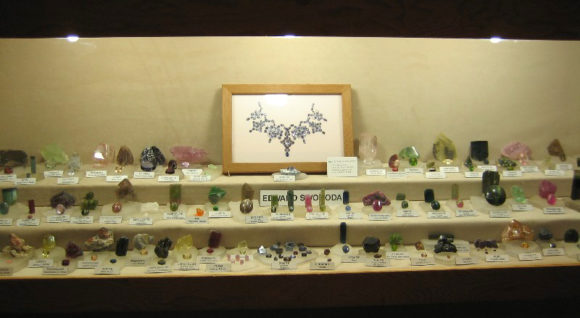
Display of cut and rough stones requires precise placement of the cut gemstones in relation to their corresponding natural crystal counterparts.
Step 5. Practice, Prepare, Pack, Present
Pay attention to the details, this is what will make or break the successful execution of your display.
- Double check the spelling and grammar on all labels and signs.
- Make sure dirt, dust, stains, or hair is removed from all fabric.
- Check all mountings for stability and adhesion.
- Do a practice set-up of your display case and see if all your minerals are clearly visible.
- Once you have decided on a final layout, take a photo of your practice display to use as a reference for real display day.
- Pack everything up backward as to how you will unpack it; pack items in the back row first, ending with the first row last.
Pack your minerals securely for transportation to the show location. Place backing boards, fabric covered inserts, risers, and other items inside bags or boxes to protect them from damage or dirt during transport. Transport signs and labels in a folder or envelope to prevent wrinkling, creasing, or other damage.
Usually display cases are set up the day before a gem show opens. You will be given instructions as to the date, time, and procedure beforehand; save these on your phone or print them out and bring them with you. Be prompt, wear your name tag if asked, follow any parking instructions, and try to finish setting up your display case in a timely fashion.
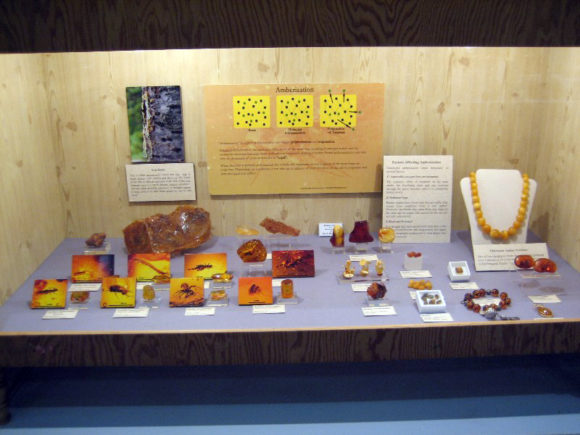
This exhibitor decided to forgo a back insert altogether and attach the signage directly to the wood of the case. Sometimes you are forced to make onsite alterations to your idea, so bring your supplies.
Bring all tools and accessories you may need to set up your display case; you cannot be sure what will be available to you. Here is an example list of items to bring along on set-up day.
- Hot glue and glue gun
- Mineral tack
- Scissors
- Hobby knife
- Masking Tape
- Duct Tape
- Iron
- Lint roller
- Thumbtacks
- Glass Cleaner
- Paper Towels
- Ruler
- Spare Stands and bases
- Tweezers or forceps
- Extension Cord
Most importantly, have fun and create a display that makes you happy. By deciding to participate in the sharing of your rocks and minerals with other members of the rockhound community, you are helping to keep our rock and gem shows interesting and diverse. All the pointers and examples in this guide are presented to help you through the process of creating your own, unique display cases with less trial and error. For more information on display cases, visit your local gem, mineral, rock or lapidary club.
